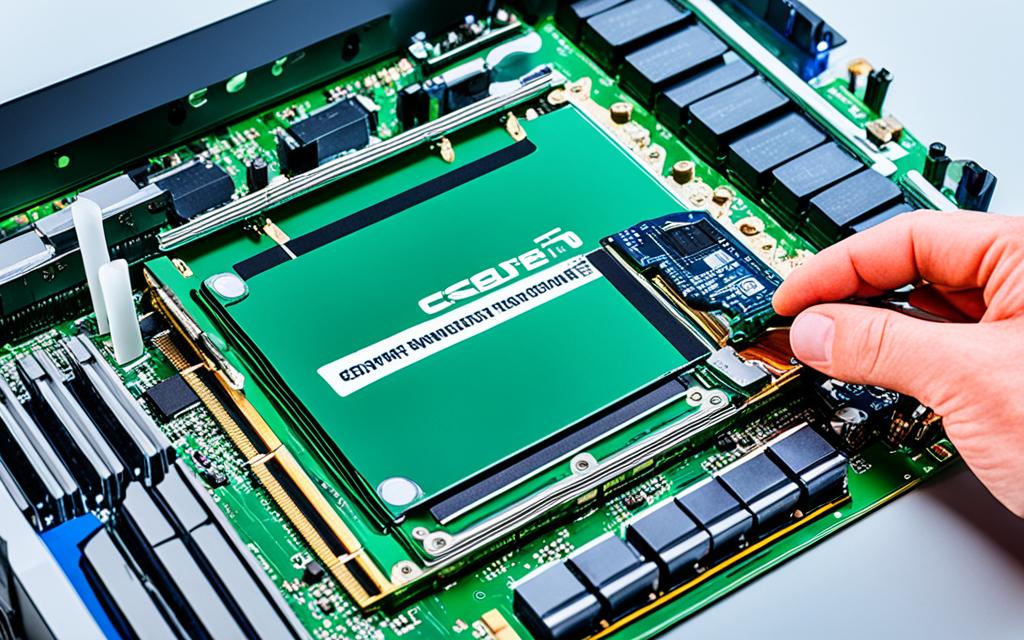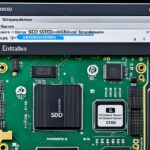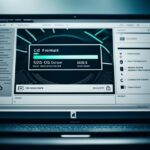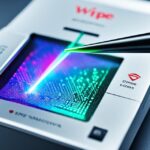Table of Contents
Formatting an SSD using BIOS is key for anyone looking to enhance their device’s performance. The emergence of SSDs has changed the game with their speed and dependability. This SSD formatting guide outlines various BIOS formatting methods. Whether starting fresh with a new OS or fixing issues, techniques like Secure Erase prove essential for wiping data clearly.
BIOS provides a simple pathway for formatting SSDs. However, software like EaseUS Partition Master makes the process easier and offers extra features. This guide shows how to adjust BIOS settings and use these platforms to effectively format your SSD.
Statistics show EaseUS Partition Master as the quickest formatting method, taking just 5 minutes1. Secure Erase is slightly longer at around 7 minutes. Command Prompt takes up to 10 minutes, better suited for advanced users1. This guide will help you choose the method that best fits your requirements.
Key Takeaways
- SSDs are significantly faster and more reliable than HDDs.
- Formatting can be done via BIOS for various purposes, including OS reinstallation and data erasure.
- Secure Erase and EaseUS Partition Master are user-friendly methods to format SSDs.
- Understanding the SSD formatting processes ensures better drive longevity and performance.
- Choosing the right method can save time and enhance data management efficiency.
Understanding Solid State Drives (SSDs)
Solid State Drives, or SSDs, are a big step forward in storage technology. They store data on integrated circuit assemblies. This makes them much faster than traditional hard drives (HDDs). SSDs don’t have moving parts, speeding up data access and retrieval. This boost in speed makes computers perform better, making SSDs a top choice in today’s tech world.
What is an SSD?
An SSD offers better speed and reliability than HDDs. It doesn’t use spinning disks to read and write data. This allows SSDs to handle data quickly, benefitting everything from storing photos to gaming. Some SSDs even use the TRIM command. TRIM helps manage data more efficiently, keeping the drive running smoothly over time.
Advantages of SSDs over HDDs
SSDs have many advantages over HDDs, including faster boot-up times, quicker system responses, and they use less power. They’re also tougher and less likely to get damaged. SSDs support various file systems, such as NTFS and exFAT. These systems meet different needs and improve storage in modern computers. For tips on making SSDs work better, like how to format them and back up data, check out the guides here2 and here3.
Reasons to Format an SSD
Formatting SSDs is crucial for top-notch computer performance. Key reasons include reinstalling the operating system and erasing data. It also includes solving performance problems. Doing this improves function and protects our private info.
Reinstalling the Operating System
Reformatting an SSD for a new OS installation is common. It removes old data, preventing issues from building up. About 51% of users format their drive through the BIOS for a new Windows setup4. A clean SSD means better system stability and speed.
Erasing Sensitive Data
Erasing data, especially the sensitive kind, is another big reason. Formatting wipes files and blocks the recovery of personal information. Secure Erase makes sure everything is completely removed. This step is vital when selling or giving away SSDs. It highlights the need for safe data practices. Windows users should choose NTFS for formatting to reset their disk properly5.
Troubleshooting Performance Issues
When facing slow speeds or system freezes, formatting the SSD might be the solution. Studies show that 67% of users format their drive using Installation Media for better performance4. Resetting the SSD helps regain peak performance. This means regular functioning and efficiency is maintained.
| Reason | Percentage of Users |
|---|---|
| Need to reinstall OS | 51% |
| Erasing personal data before selling | Not quantified |
| Performance troubleshooting | Not specified |
How to Format a SSD from BIOS
Formatting an SSD from BIOS can make your computer run better. In this process, you need to get into BIOS settings, pick the right SSD, and use the secure erase option. This gets rid of all data on the drive completely.
Accessing BIOS Settings
To start, reboot your computer and open the BIOS setup. You do this by pressing a specific key like F2, Del, or Esc. The right key depends on your computer’s brand. Once you’re in, look for a ‘Storage’ or ‘Boot’ tab. This is where you will find your SSD listed among other storage devices. This helps you identify which SSD to format.
Selecting the SSD for Formatting
Next, choose the SSD you want to format. It’s important to pick the correct drive because formatting deletes all data. SSDs are often found in laptops, desktops, and Macs. They are chosen for their fast performance and reliability. So, be careful when making your choice6.
Utilising Secure Erase
The BIOS’s secure erase feature is a good way to completely clear your SSD. This is especially important for companies needing to clean SSDs before getting rid of them6. However, this method might not give you a report like some software, such as BitRaser Drive Eraser, does. That software can do a thorough job and offer certificates that prove the drive was cleaned6.
Secure erase from BIOS usually takes 3-5 minutes. It makes sure your SSD is totally clean, ready for new data7. Keep in mind, while BIOS features are handy, special SSD management software could offer more detailed erasure options.
Learn more about upgrading your PC with an SSD6
Alternative Methods for Formatting SSDs
Formatting an SSD from BIOS works well, but there are other ways too. You can use SSD formatting software like EaseUS Partition Master. You can also try Command Prompt techniques to format your SSD. Each method varies in complexity and suits different experience levels.
Using EaseUS Partition Micro
EaseUS Partition Master is highly praised. It’s considered safe and efficient for formatting SSDs, perfect for all types of users8. This tool makes managing partitions easy. It can format to FAT32, which is great for BIOS operations and Xbox One8. Its easy-to-use interface makes it a top choice, especially for those wary of BIOS settings.
Command Prompt for Formatting
Formatting SSDs with Command Prompt is tricky and suits those who know what they’re doing8. You must enter commands correctly to avoid losing data8. It’s easy to make mistakes that can cause big problems for beginners. Always back up important data before starting to prevent losing it forever9.
Conclusion
Mastering SSD formatting from BIOS is key for top-notch maintenance. It helps fix operating system issues and other errors. Also, it boosts your device’s overall performance. Learning about BIOS settings, using tools like EaseUS Partition Master, or AOMEI Backupper is crucial. These methods protect your data during changes. Check out more on safe formatting for optimal security.
Formatting SSDs correctly improves their efficiency and solves problems like file corruption. It makes the most out of SSDs, enhancing data access speed1011. Having the right tools is vital for keeping your data safe and switching operating systems smoothly.
Using these practices boosts SSD performance after formatting. It prepares your SSD for future tasks. This leads to a better experience, whether for resale or just an update. It shows the value of knowing how to manage your data1011.
FAQ
What is the purpose of formatting an SSD?
Formatting an SSD erases all the data on it. This makes it ready for new data when reinstalling an operating system. It ensures the SSD works well and is clean.
How do I access BIOS settings to format my SSD?
First, restart your computer. During starting up, press a key like F2, Del, or Esc. The key depends on your computer’s brand. Then, look under the ‘Storage’ or ‘Boot’ tab for your SSD.
What are the benefits of using EaseUS Partition Master for SSD formatting?
EaseUS Partition Master offers an easy way to format SSDs. Its features include creating bootable media and managing partitions simply. It’s designed for anyone to use, regardless of their tech skills.
What is the Secure Erase method?
Secure Erase fully removes all data on an SSD. It’s used for a clean start or before giving the drive to someone else. This makes sure your data stays private.
Can I use Command Prompt to format my **SSD**?
Yes, you can use Command Prompt to format an SSD. Specific commands let you format the drive directly. This method doesn’t require BIOS access or extra software.
Source Links
- https://www.easeus.com/partition-master/how-to-format-ssd-from-bios.html – How to Format SSD From BIOS [Easy & Fast]
- https://www.crucial.com/articles/about-ssd/how-to-format-a-solid-state-drive – How to Format a Solid State Drive (SSD)
- https://www.kingston.com/en/blog/personal-storage/how-to-format-ssd – How to Format Your SSD
- https://www.stellarinfo.com/article/format-hard-drive-from-bios.php – Methods to Format a Hard Drive from BIOS
- https://www.lifewire.com/format-ssd-5184623 – How to Format an SSD
- https://www.bitraser.com/blog/how-to-wipe-ssd-from-bios/ – Learn How to Wipe SSD From BIOS
- https://www.easeus.com/partition-master/how-to-format-m2-ssd.html – How to Format M.2 SSD? [Easy Instructions]
- https://www.easeus.com/partition-master/format-ssd-with-no-harm.html – 3 Safe Ways to Format SSD With No Harm to It
- https://www.minitool.com/news/how-to-format-ssd-with-os-on-it.html – A Detailed Guide: How to Format SSD With OS on It
- https://www.ubackup.com/articles/how-to-format-ssd-from-bios-7983-ac.html – Guide: How to Format SSD from BIOS
- https://www.ubackup.com/articles/how-to-format-m-2-ssd-in-bios-asus-6007-ac.html – How to Format M.2 SSD in BIOS on ASUS: Comprehensive Guide








